By Abiola Gbolahan
Edited By Fredrick Oladipupo
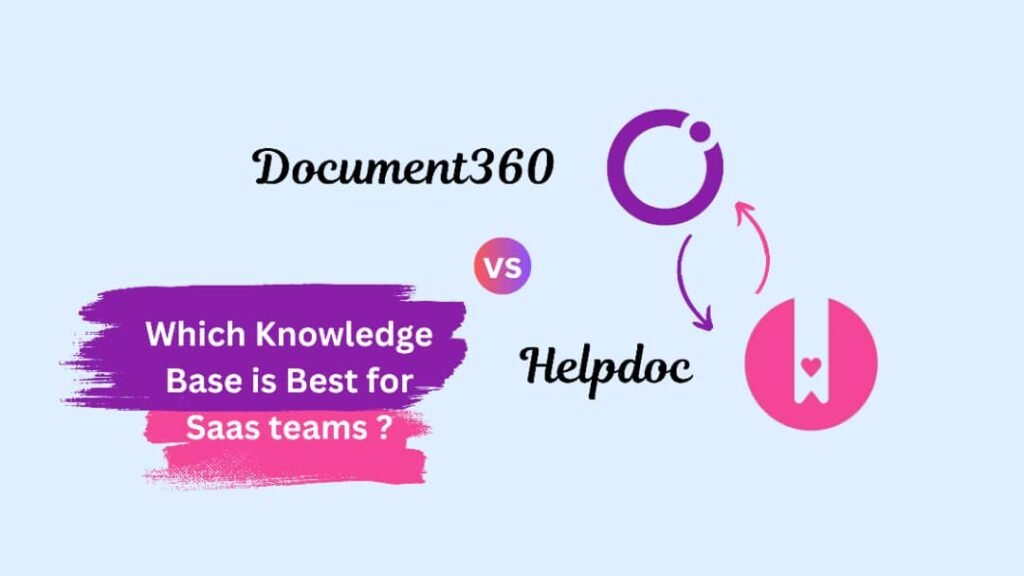
Table of Contents
1. Introduction
For SaaS teams, having a reliable knowledge base isn’t optional, it’s a key part of delivering consistent support and keeping everyone on the same page. Whether you’re building customer-facing help docs or internal guides for your team, the right tool can make all the difference.
Document360 and HelpDocs are two well-known platforms designed to help teams create, manage, and organize documentation effectively. While they share some similarities, each one offers a unique set of features and strengths.
In this blog, we’ll compare Document360 vs HelpDocs across important areas like usability, features, integrations, pricing, and more, so you can choose the one that works best for your team’s needs.
2. Overview: Document360 vs HelpDocs
Before comparing features in detail, it’s helpful to understand what each platform is built for. Document360 and HelpDocs both serve the same core purpose whuch is helping SaaS teams manage and share knowledge but they take slightly different approaches in design, functionality, and target users. Here’s a quick look at what each one offers.
2.1 Document360
Document360 is a powerful knowledge base platform designed to help teams create, manage, and publish self-service documentation. Launched with a clear focus on serving SaaS businesses, Document360 is built to support both customer-facing help centers and internal knowledge management.
One of its standout qualities is its ability to scale with growing teams. It offers granular access controls, advanced versioning, and powerful content organization features which make it especially appealing to enterprise-level teams that manage large volumes of information. Whether you’re building product documentation, internal SOPs, or onboarding guides, Document360 provides the structure and tools to keep it all organized.
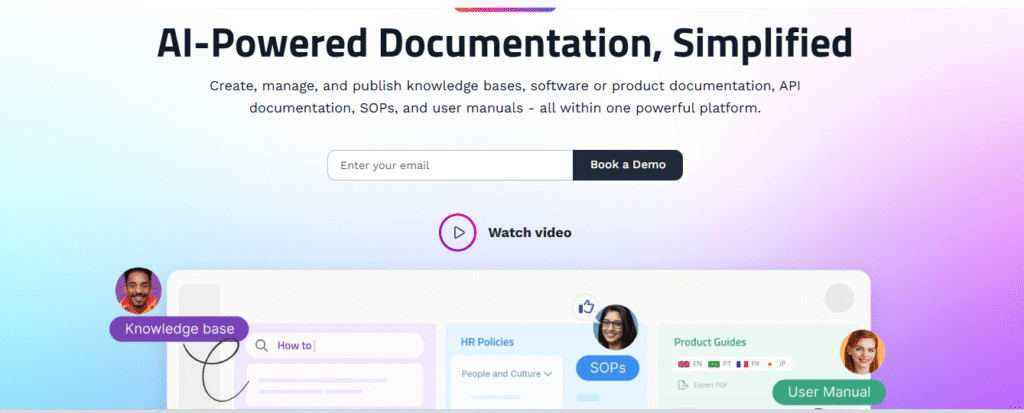
Its editor supports both Markdown and WYSIWYG modes, giving writers and technical contributors the flexibility to work the way they prefer. Combined with rich analytics and strong integration capabilities, Document360 has become a go-to choice for SaaS teams that need a robust and professional documentation solution.
2.2 HelpDocs
HelpDocs is a clean, user-friendly knowledge base tool created with simplicity and speed in mind. It focuses on helping companies deliver polished, easy-to-navigate support content without the need for extensive setup or technical know-how.
Originally built for startups and small teams, HelpDocs emphasizes a smooth user experience both for content creators and end-users. The interface is minimalistic yet efficient, allowing teams to quickly create articles, customize their help center’s look and feel, and go live in very little time.

What makes HelpDocs appealing is its focus on providing just the right amount of features without overwhelming users. It includes essential tools like article analytics, search optimization, feedback collection, and light customization which make it ideal for teams that want to keep things simple while still delivering high-quality support content.
If you’re looking for a streamlined, no-fuss knowledge base platform that still looks professional and performs well, HelpDocs is a strong contender.
3. Features Comparison
| Feature Area | Document360 | HelpDocs |
|---|---|---|
| Article Management | Offers both Markdown and WYSIWYG editors for flexibility. Supports collaborative editing, drafts, and a structured publishing workflow. | Uses a simple editor with Markdown support. Easy to use but less advanced for collaboration. |
| Customization & Branding | Highly customizable themes, layout options, and white-labeling. Supports custom CSS and full control over branding. | Clean, minimal customization. Allows some branding tweaks and supports custom domains. White-labeling is limited. |
| Search Functionality | Fast, intelligent search with support for AI-powered suggestions and in-depth search analytics. | Reliable and fast search. Basic analytics available, but lacks advanced AI suggestions. |
| Access Control & Permissions | Advanced role-based permissions, ideal for large or multi-team environments. Supports private and public knowledge bases. | Basic access controls. Works well for smaller teams but lacks complex permission settings. |
| Version History & Backups | Tracks full article version history, with easy restore options and regular backups. Auto-save helps prevent data loss. | Basic version history and autosave features are available but not as detailed or advanced. |
4. Integrations and API Support
Both Document360 and HelpDocs recognize the importance of connecting seamlessly with other tools that SaaS teams use every day.
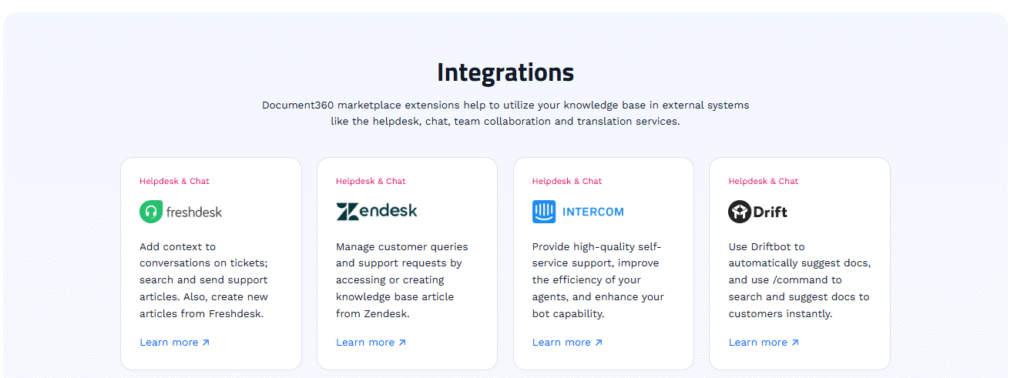
Document360 offers a wide range of native integrations with platforms like Intercom, Slack, Zendesk, Microsoft Teams, and more. It also connects well with automation tools like Zapier, making it easier to streamline workflows across departments.
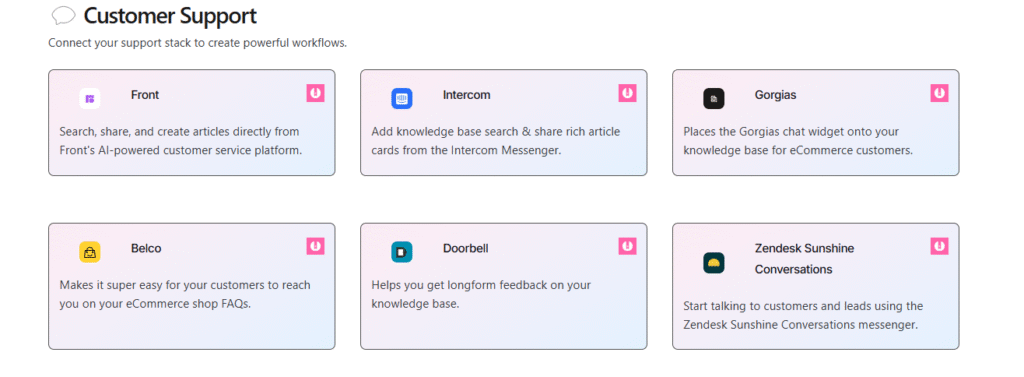
HelpDocs, while offering fewer native integrations, still supports popular tools such as Intercom and Slack. It also works with Zapier to cover broader automation needs, though it may require a bit more configuration compared to Document360.
For developers, Document360 shines with its detailed and well-structured API documentation, allowing teams to build custom workflows or embed content with confidence. It also supports webhooks, making it suitable for more advanced automation and event-triggered actions. HelpDocs also provides API access, but its documentation is more basic, aimed at simpler use cases and smaller dev teams.
5. User Experience and Ease of Use
When it comes to getting started, both Document360 and HelpDocs offer relatively smooth onboarding experiences but they cater to slightly different user types.
Document360 provides a more feature-rich dashboard, which can be great for teams that need advanced control. However, this also means the setup process can feel a bit more complex, especially for new users. The interface is clean and professional, but navigating through all the options might require a short learning curve particularly for non-technical users. That said, once you’re familiar with the layout, managing and organizing content becomes very efficient.
HelpDocs, on the other hand, is built with simplicity in mind. Its setup is fast, and the dashboard is minimal and intuitive. You can get a knowledge base up and running quickly without needing to dig through documentation or tutorials. This makes it especially appealing to startups or smaller teams who want a no-fuss experience.
6. Analytics and Insights
Understanding how your knowledge base is performing is key to improving support and keeping content relevant. Both Document360 and HelpDocs offer helpful analytics to guide those decisions.
Document360 provides a comprehensive analytics dashboard that tracks article views, user engagement, and performance over time. It also gives you insights into how visitors are interacting with your content like which articles are most viewed, where users drop off, and what they’re searching for. You can also gather feedback directly on articles, helping your team identify what’s helpful and what needs improvement.
HelpDocs keeps things simpler but still covers the essentials. You can see which articles are performing well, what users are searching for, and how often they leave feedback. While it may not go as deep as Document360 in terms of user behavior tracking or advanced metrics, it still gives small to mid-sized teams enough insight to refine their content strategy.
7. Pricing and Plans
When choosing a knowledge base platform, pricing can be just as important as features especially for SaaS teams balancing growth with budget.
7.1 Document360 Pricing
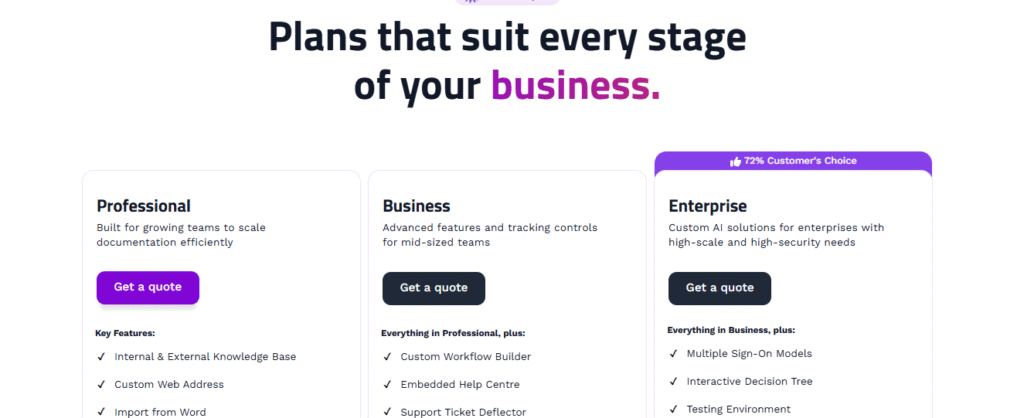
Document360 offers a tiered pricing structure designed to support teams of all sizes. As of 2025, Document360 pricing’s plan was reported by a verified user to start at $99/month per project(Startup plan) and scale up depending on your team’s needs. Each tier includes access to core features like version control, analytics, and integrations, but the more advanced features such as custom roles, audit logs, and private hosting are reserved for higher-tier plans like Business and Enterprise. Document360 also offers a 14-day free trial, allowing teams to test the platform before committing. Visit the offcial pricing page to get the up to date quote.
7.2 HelpDocs Pricing

HelpDocs, on the other hand, starts at a slightly higher entry point which is $69/month (Billed monthly and there is a discount of 20% if you opt in for annual Billing) for its start plan. However, it includes unlimited articles and supports branding customization, basic analytics, and integrations even at the base level. Higher-tier plans unlock features like more team members, private articles, and advanced customization options. HelpDocs also provides a 7-day free trial, giving users a quick way to evaluate the tool. Visit HelpDoc Pricing’s page
In terms of cost-effectiveness, Document360 tends to be more suitable for larger teams or organizations with complex documentation needs and structured workflows. Its higher pricing is justified by its enterprise-grade features and scalability. HelpDocs, by contrast, is more affordable for smaller teams or startups that want a clean, easy-to-manage knowledge base without unnecessary extras.
8. Pros and Cons: Document360 vs HelpDocs
| Platform | Pros | Cons |
|---|---|---|
| Document360 | – Feature-rich (version control, roles, workflows) – In-depth analytics and insights – Scales well for large or enterprise teams – Dual editor support (Markdown + WYSIWYG) – Broad integration and API support | – Higher learning curve for new users – Starts at $149/month which can be costly for small teams – Interface can feel overwhelming at first |
| HelpDocs | – Very easy to use and set up – Lower starting price ($69/month) – Clean, professional design – Quick publishing and basic customization – Ideal for startups and small teams | – Lacks advanced features like granular roles and deep versioning – Fewer third-party integrations – Basic analytics and limited customization |
9. Who Should Use Each Tool?
Both Document360 and HelpDocs are solid knowledge base platforms, but they serve slightly different needs depending on your team size, structure, and goals. Here’s how to decide which one might be the better fit based on your situation:
9.1 Startups vs. Established SaaS Businesses
If you’re running a startup or small SaaS team, HelpDocs is likely the better choice. It’s simple, fast to set up, and has a clean, modern interface that doesn’t require a technical background to use. For teams that need to launch a public help center quickly without much customization or internal complexity, HelpDocs offers just the right balance of ease and functionality at a more affordable starting price.
On the other hand, Document360 is better suited for established or scaling SaaS companies that require more advanced features. It supports larger teams, complex documentation workflows, and offers enterprise-ready tools like detailed permissions, audit logs, and private/internal knowledge base options. If you’re managing a high volume of content or need stricter control over publishing and user roles, Document360 is a smarter long-term investment.
9.2 Technical Teams vs. Customer Support Teams
For technical teams especially those who prefer working in Markdown, want API access, and need advanced content control, Document360 is the clear winner. It offers a flexible editing experience, supports developer integrations, and provides tools for managing documentation at scale.
Meanwhile, HelpDocs is ideal for customer support teams who want a lightweight tool that’s easy to manage without developer help. Its user-friendly interface and straightforward structure make it perfect for non-technical users who just need to publish helpful content and keep it organized.
9.3 Internal Knowledge Base vs. Public Help Center
If your primary goal is to build an internal knowledge base for your team like SOPs, product guides, or onboarding documents. Document360 is better equipped. It offers private access controls, role-based permissions, and secure publishing options that make it ideal for internal use.
However, if you’re mainly focused on creating a public help center for customers, HelpDocs shines. It’s designed for customer-facing documentation with clean layouts, mobile responsiveness, and fast search all with minimal setup required.
10. Conclusion: Document360 vs HelpDocs
As you weigh your options, here’s a clear comparison and recommendation to help you decide between Document360 and HelpDocs.
10.1 Recap of Key Differences
Document360 is feature-rich and built for scale, offering detailed access controls, versioning, advanced analytics, and strong API integrations which is ideal for structured workflows and internal documentation.
While HelpDocs focuses on simplicity and speed. Its clean interface, minimal onboarding, and essential analytics make it perfect for customer-facing content and support teams.
10.2 Recommendations Based on Team Size, Goals & Documentation Needs
- Small startups or early-stage SaaS teams benefit from HelpDocs. You can launch quickly and manage a public knowledge base easily without heavy configuration or technical support.
- Medium to large SaaS organizations or scaling teams will find Document360 more suitable. With its expansive feature set, it handles complex documentation needs and internal guidelines more effectively.
- For technical teams, Document360’s support for Markdown, APIs, and integrations makes it a more flexible and developer-friendly tool.
- For support and non-technical teams, HelpDocs offers a lighter learning curve and efficient article creation without the overhead.
10.3 Final Thoughts for Decision-Making
Nowadays, the right knowledge base platform is one that not only solves today’s documentation needs but also grows with your team. HelpDocs is a smart, cost-effective choice when clarity, speed, and ease of use matter most. Meanwhile, Document360 is built for durability and depth which is perfect if you expect to scale or manage internal processes with precision and structure.
Related Reads from PlatformAdviser
- Scribe vs Tango Comparison: Which is Best AI SOP Generator? — A deep dive into AI tools for automating SOP and documentation workflows.
- Refiner vs AskNicely Compared: Which Feedback Tools for SaaS? — An in‑depth look at customer feedback platforms and use cases.
- Dorik vs Carrd: Best Lightweight Landing Page Builder in 2025 — Comparison of two simple page builders ideal for SaaS websites.
- Framer vs Webflow: Which No‑Code Website Builder is Best for Designers? — A guide for choosing between no-code website building platforms.
- ChatGPT vs Jasper AI for Marketing Content — A detailed comparison of two AI assistants for content creation.



Pingback: Slack vs Discord: Best Communication Tool for Remote Teams - Platform Adviser